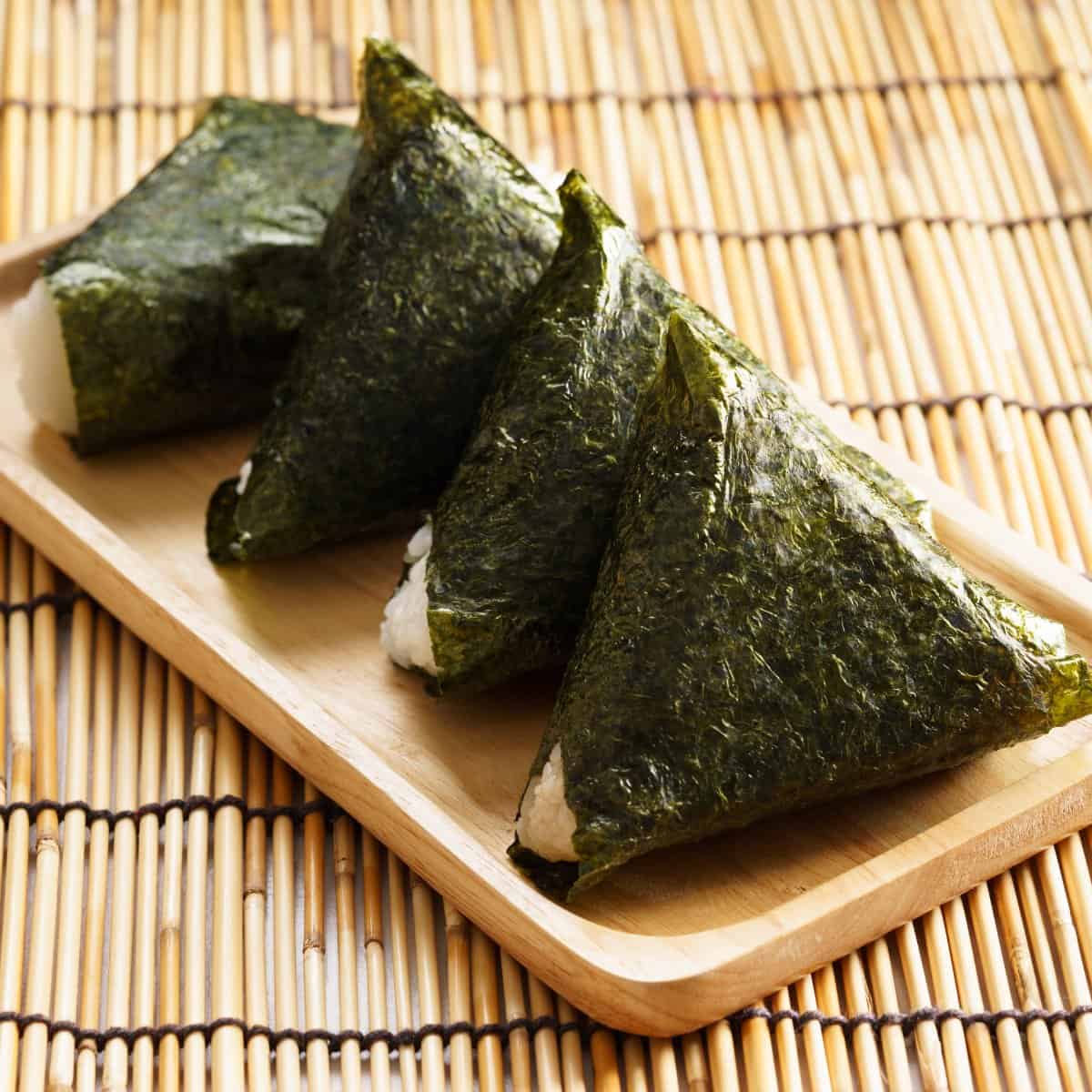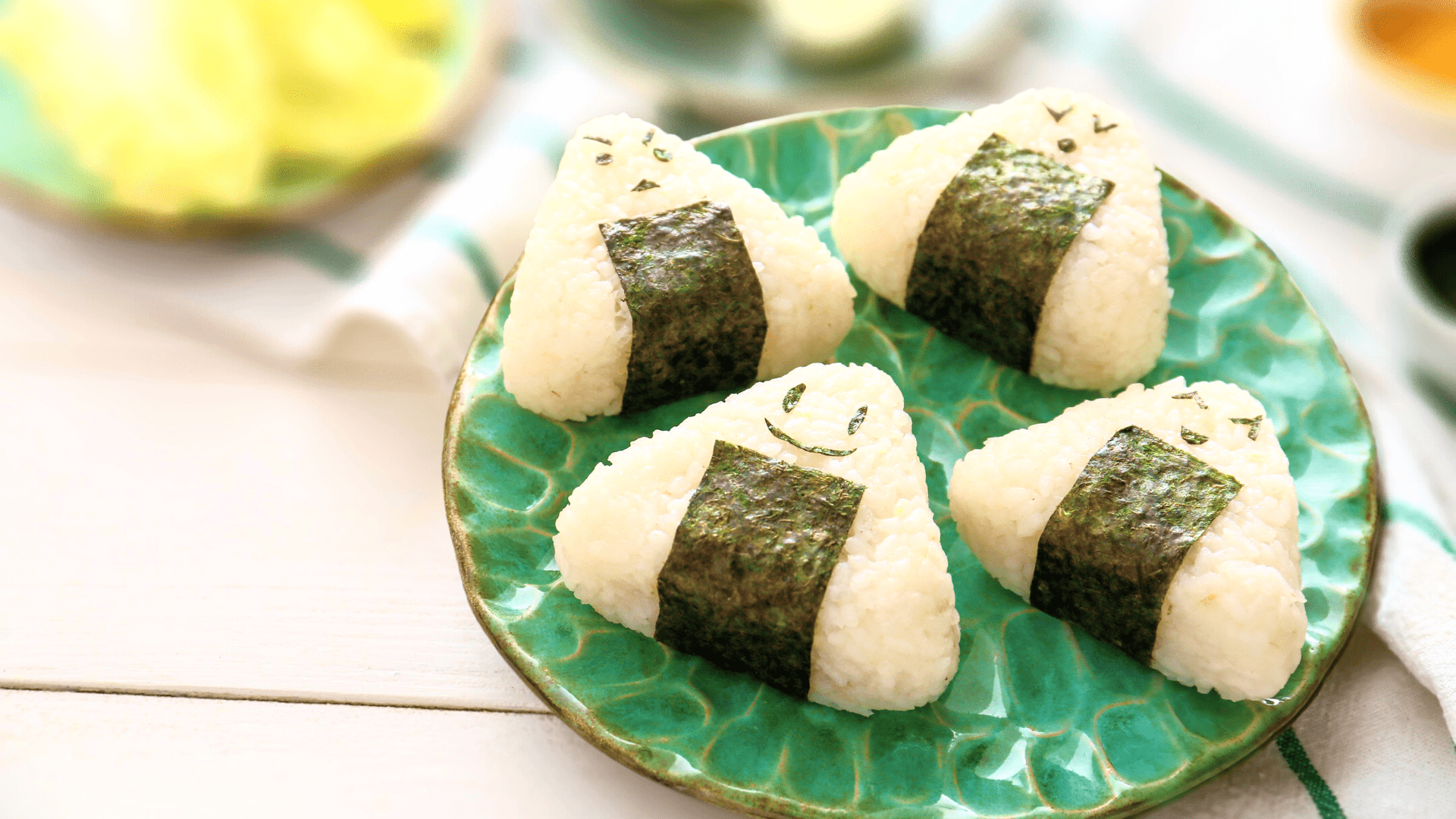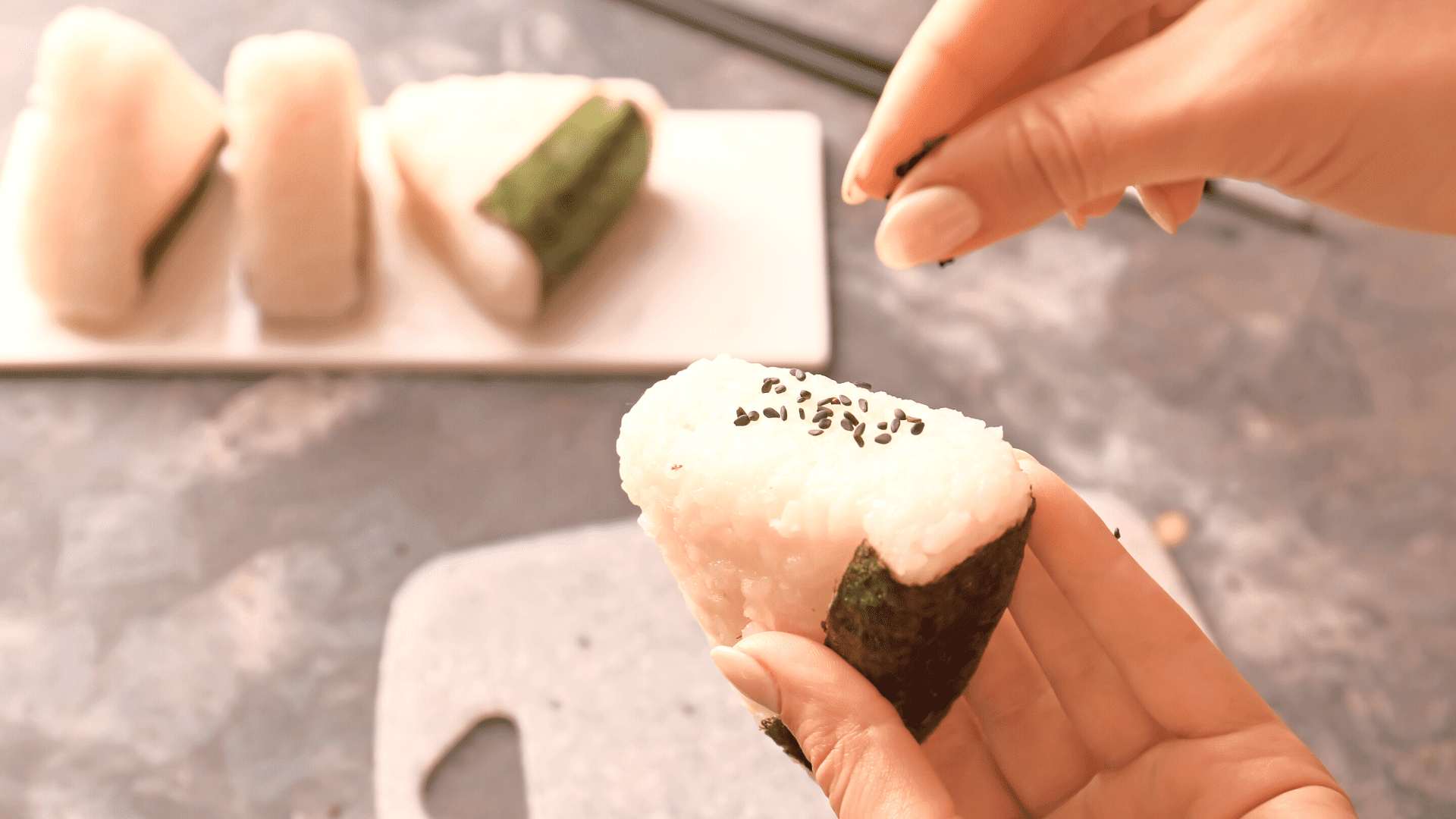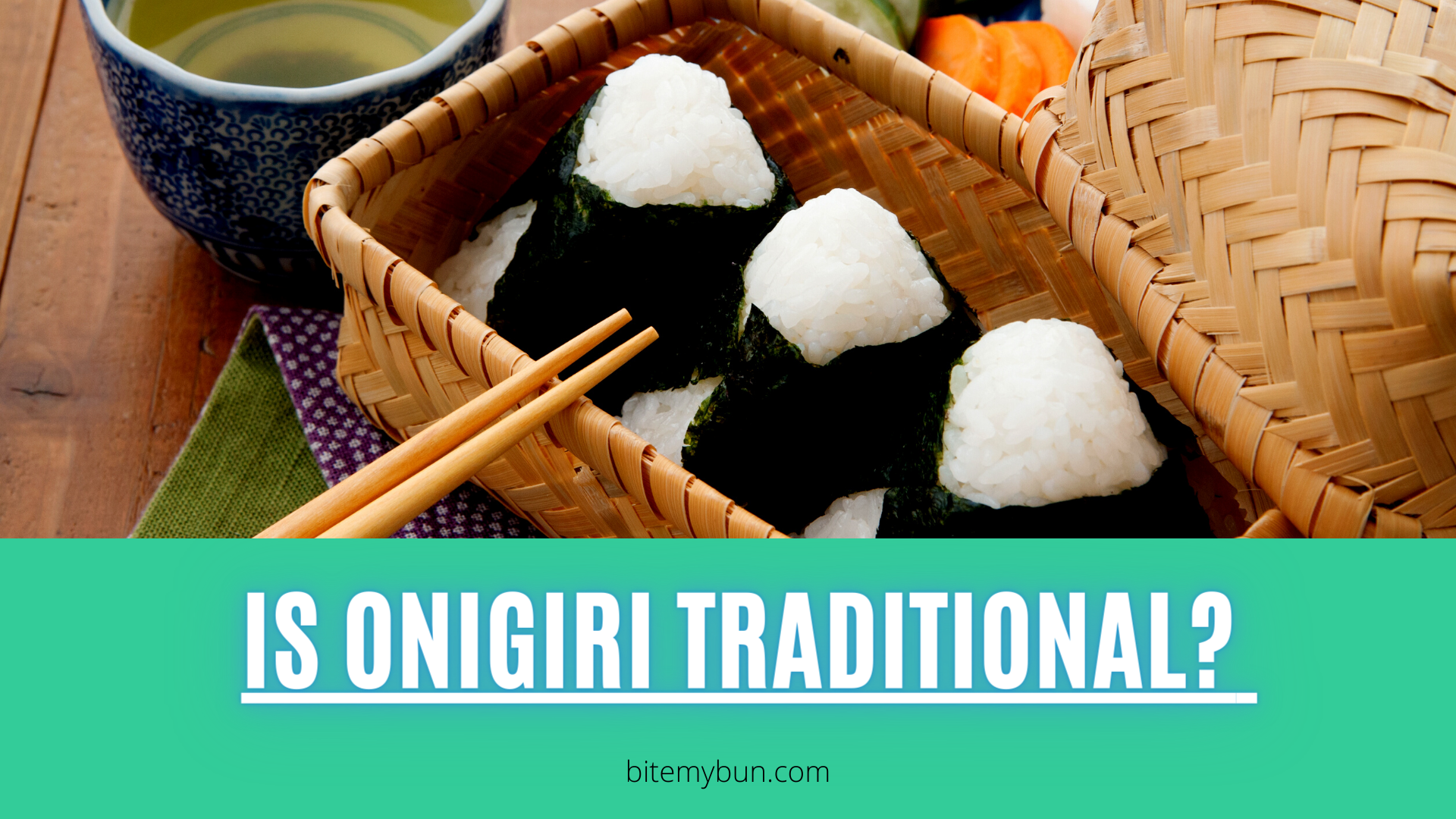Onigiri: Perfect Japanese Rice Ball Snacks On-The-Go
Also known as omusubi, onigiri is mostly shaped into triangles or balls by hand. They’re the staple of Japanese lunchboxes (bento), and are fun to make!
Just like sandwiches in the west, Japanese rice balls can be found in almost any convenience store across Japan, and they’re ideal for munching while on the go.
In the past few years, onigiri has become very popular in food trucks, where they’re freshly made, and grilled lightly to order.
Onigiri, or rice ball, is a Japanese food made from white rice formed into triangular or oval shapes and often wrapped in nori (seaweed). Traditionally, an onigiri is filled with pickled ume (umeboshi), salted salmon, katsuobushi, kombu, tarako, or any other salty or sour ingredient as a natural preservative.

Because of the popularity of onigiri in Japan, most convenience stores stock their onigiri with various fillings and flavors. There are even specialized shops that only sell onigiri to take out.
Onigiri is also known as omusubi, although it’s not exactly the same thing. You can also find it grilled, which is called yaki onigiri.
Onigiri, also called omusubi (おむすび) or nigirimeshi (握り飯), is a type of Japanese sticky rice ball that comes in a triangular or cylindrical shape. It’s often covered with nori seaweed.
Some onigiri is also filled with salted salmon, umeboshi (pickled plum), or bonito flakes, just to name a few.
It’s one of the most popular snacks and lunchbox items, especially as part of bento boxes. So you might’ve seen them in kids’ lunchboxes before!

Check out our new cookbook
Bitemybun's family recipes with complete meal planner and recipe guide.
Try it out for free with Kindle Unlimited:
Read for freeIn this post we'll cover:
Why is onigiri a triangle?

Actually, onigiri comes in 4 different shapes, but the triangle is probably Japan’s most famous.
But are you curious to know why exactly these rice balls aren’t actually ball-shaped, but rather, triangular?
The reason why onigiri is a triangle has to do with an old legend.
Apparently, travelers crossing through Japan were afraid of spirits called kami. Shintoists believed that kami lived in all of nature’s elements. So to protect themselves from the spirits, the travelers molded their rice snacks into triangles that resembled mountains.
But some people also believe the triangle shape was a result of people looking for practical and space-efficient foods and snacks. Since onigiri is often taken to work, it should be easy to carry around, and triangles fit into lunch boxes perfectly.
Is onigiri traditional?

Triangle onigiri isn’t a new dish. In fact, Japanese people ate rice balls as early as the 11th century AD.
However, back then, onigiri was called tonjiki.
It was still eaten as a lunchtime meal or snack by workers on their lunch break. Warriors would also eat onigiri during their break from fighting because the rice balls were easy to transport, but they were filling and relatively nutritious.
Onigiri only took on the now-famous triangle shape in the 1980s when onigiri was made with machines. These machines shaped the rice patties into these tasty triangles.
Now you can find pre-packaged onigiri at all Japanese food shops or fresh ones at most restaurants and pubs.
Onigiri, literally meaning: Rice Ball, or Demon Slash if you’re a fan of One Piece, is an incredibly popular snack or meal choice for many families, be they of Asian descent, or otherwise.
Onigiri is made from a combination of sugar, rice, and seaweed (that black wrap at the bottom of onigiri, or its entire wrapping).

Onigiri is a traditional dish that dates back to 11th century Japan. The earliest record is that of Murasaki Shikibu remarking that people are eating little white rice balls.
Onigiri and samurai
Though, their exact introduction to history is unknown, with the most common record being that of onigiri being taken to picnics and, evidently, battles.
Many samurai or Ashigaru (foot soldiers), stored onigiri in bamboo to be used for later.
This is mostly due to the fact that onigiri can be kept over a long period of time, so you don’t have to eat them straight away like many cooked foods. In other words, they are excellent rations.
They do contain a high-calorie count, which is a problem for people watching their health, but if you’re on the move a lot, like a soldier or a wandering monk, then a good onigiri will keep you full.
Check out these 3 Japanese Rice Balls recipes | how to make Onigiri and Ohagi
In addition, to keep the onigiri fresh, they were often stuffed with Umeboshi or dried ume.
Ume, not the bank, is a dried fruit that contains many antibacterial properties that keep the onigiri from becoming spoiled or dirty, which is important for long trips.
Onigiri is similar to omusubi, but not the same.
Different flavors and shapes
Onigiri comes in many flavors and ways to make, and are popular due to their taste, and ease of making. See, Onigiri is a very simple dish, being composed of, again, sugar, rice, and seaweed.
Plus, their small size makes them easy to carry in lunchboxes and other packages, making them a favorite of many school students. Even in the adult world, onigiri is a favorite of salarymen.
A few different methods of making onigiri pop up several times throughout history, with each one going through a different phase, or faze as the case may be. Kind of like how cookie cutters can make cookie dough appear different.
For example, a recent craze is taking onigiri and making them appear as custom shapes, like animals.
A historical example of an onigiri craze would be when the seaweed wrap became more commonplace. During the Edo period, commoners would wrap it in dried seaweed to help preserve the dish.
How about a fried, or Yaki, onigiri recipe? It’s the perfect Japanese rice ball snack for drinks & friends
Easy, tasty, and traditional
So, yeah, all in all, onigiri is a pretty traditional meal that is favored throughout Japan’s history. It is small, easy to make, and is popular in the west as well.
Much like sushi, it is pretty easy to find in certain grocery stores if you know what to look for. Or, heck, you can try making it yourself.
Being simple and easy to look up, onigiri is a staple of many households today. Be it Eastern or Western, Onigiri are a tradition that has been passed down throughout the generations.
It is honestly kind of a wonderful thing, to find a recipe so timeless that it hasn’t changed too much throughout the centuries.
Still, you should probably be aware that onigiri can be addictive, and it can add some serious weight. So be careful if you’re on a diet, or are eating too much.
Onigiri is more of a Japanese snack food than an actual mainline meal you can have every day, so be certain not to eat too much.
So, a quick summary: onigiri are great if you’re on the move, a samurai, or just want to have something tasty on hand and don’t need to worry about carbs.
To top your onigiri, try Furikake Seasoning | Top brands or make your own like this!
Have these yummy triangular Japanese rice balls
Did you know that every year on June 18th, the Japanese celebrate Onigiri Day? It’s a fun nod to one of the country’s most beloved dishes.
Check out our new cookbook
Bitemybun's family recipes with complete meal planner and recipe guide.
Try it out for free with Kindle Unlimited:
Read for freeJoost Nusselder, the founder of Bite My Bun is a content marketer, dad and loves trying out new food with Japanese food at the heart of his passion, and together with his team he's been creating in-depth blog articles since 2016 to help loyal readers with recipes and cooking tips.
